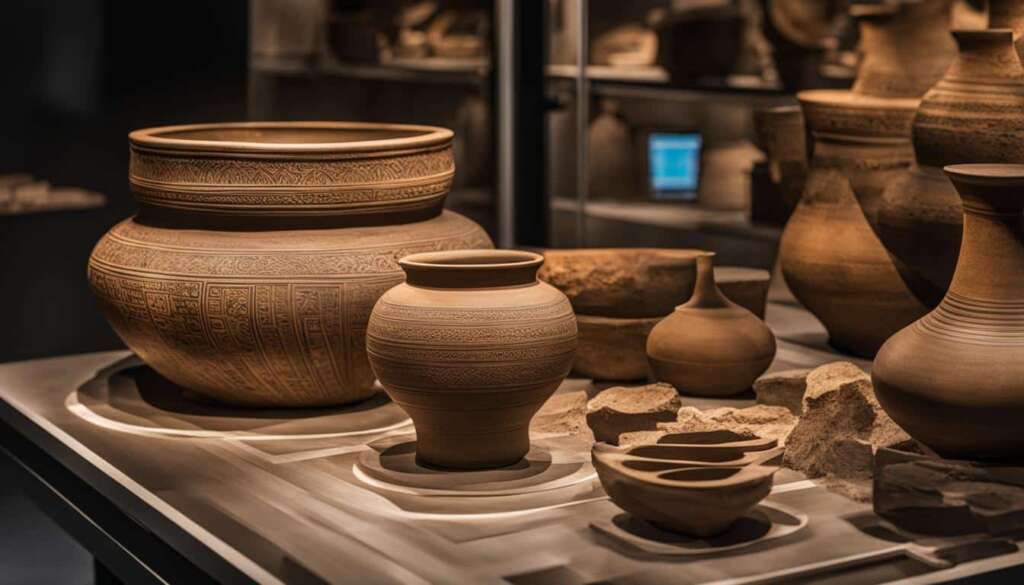Table of Contents
New technology is revolutionizing the field of biblical era archaeology, allowing researchers to unlock the secrets of ancient history. With the help of cutting-edge archaeological analysis, scientists are making groundbreaking discoveries and shedding new light on biblical artifacts and historical research.
Recent technological advancements have greatly enhanced the capabilities of archaeological analysis. For example, the use of Raman-activated cell sorting devices and 13C-labeled single-cell Raman spectra has enabled researchers to measure key metabolic phenotypes in single cyanobacterial cells with precision and efficiency. This method eliminates the need for time-consuming cell separation and cultivation, allowing for rapid growth screening of cyanobacteria. Additionally, the integration of controllable springs in three-dimensional structures using confocal photolithographic manufacturing has opened up new possibilities for mechatronic devices at smaller scales. These technological advancements have significantly contributed to the field of biblical era archaeology.
The use of new tech in biblical era archaeology has led to uncovering fascinating archaeological discoveries that provide insights into ancient history. For example, the application of iCyanVS technology has allowed researchers to identify and isolate engineered cyanobacterial single cells with robust growth, providing valuable information about the growth rate and carbon fixation rate at the single-cell level. Additionally, the integration of “picosprings” in microbots has enabled precise measurements of forces and interactions at the cellular level, leading to a better understanding of ancient civilizations and their practices. These advancements in new tech have opened up a whole new world of possibilities in the study of biblical era archaeology.
Technological Advancements in Archaeological Analysis
Recent technological advancements have greatly enhanced the capabilities of archaeological analysis. These advancements have revolutionized the field of biblical era archaeology, allowing researchers to uncover new insights into ancient civilizations and their practices.
One significant technological advancement is the use of Raman-activated cell sorting devices and 13C-labeled single-cell Raman spectra. This cutting-edge method enables researchers to measure key metabolic phenotypes in single cyanobacterial cells with precision and efficiency. By eliminating the need for time-consuming cell separation and cultivation, this technology allows for rapid growth screening of cyanobacteria, contributing to faster and more accurate analysis in biblical era archaeology.
Furthermore, the integration of controllable springs in three-dimensional structures using confocal photolithographic manufacturing opens up new possibilities for mechatronic devices at smaller scales. This advancement enables researchers to develop innovative tools for precise measurements, leading to a deeper understanding of ancient civilizations and their technological advancements.
These technological advancements have significantly contributed to the field of biblical era archaeology, providing researchers with powerful tools to analyze archaeological artifacts and uncover the secrets of ancient history.
To illustrate the impact of these technological advancements, consider the following table that highlights the key advancements in archaeological analysis:
| Technological Advancements | Benefits |
|---|---|
| Raman-activated cell sorting devices and 13C-labeled single-cell Raman spectra | Precise measurement of key metabolic phenotypes in single cyanobacterial cells |
| Integration of controllable springs in three-dimensional structures | Enhanced development of mechatronic devices for precise measurements |
As shown in the table, these technological advancements have revolutionized archaeological analysis, enabling researchers to delve deeper into the mysteries of the biblical era and gain a more comprehensive understanding of ancient civilizations.
With the continuous advancement of technology, the future of archaeological analysis holds immense promise. The marriage of technology and archaeology has opened up new avenues of discovery, allowing us to unravel the secrets of the past and gain valuable insights into our shared human history.
Uncovering Ancient History through New Tech
The use of new tech in biblical era archaeology has revolutionized our understanding of ancient history. Through the application of innovative technologies, researchers have made fascinating archaeological discoveries that provide valuable insights into ancient civilizations and their practices.
One such technology, iCyanVS, has played a crucial role in identifying and isolating engineered cyanobacterial single cells. By analyzing the growth rate and carbon fixation rate at the single-cell level, researchers have gained a deeper understanding of ancient agricultural practices and the development of early societies.
Another groundbreaking advancement is the integration of “picosprings” in microbots. These microscopic springs enable precise measurements of forces and interactions at the cellular level. By studying these interactions, researchers have unveiled intricate details about ancient architectural techniques, revealing the ingenuity and advanced engineering skills of past civilizations.
The emergence of new tech has truly opened up a world of possibilities in the study of biblical era archaeology. This innovative approach to archaeological analysis allows us to uncover hidden aspects of ancient history, painting a more comprehensive picture of our past and deepening our understanding of the rich tapestry of human civilization.
FAQ
How has new technology revolutionized biblical era archaeology?
New technology has greatly enhanced the capabilities of archaeological analysis, allowing researchers to unlock the secrets of ancient history and make groundbreaking discoveries in the field of biblical era archaeology.
What are some examples of recent technological advancements in archaeological analysis?
Recent technological advancements include the use of Raman-activated cell sorting devices and 13C-labeled single-cell Raman spectra, which enable precise measurement of key metabolic phenotypes in single cyanobacterial cells. The integration of controllable springs in three-dimensional structures using confocal photolithographic manufacturing has also opened up new possibilities for mechatronic devices at smaller scales.
How has new tech contributed to the field of biblical era archaeology?
The use of new tech in biblical era archaeology has led to the uncovering of fascinating archaeological discoveries, providing valuable insights into ancient history. For example, technologies like iCyanVS have allowed researchers to identify and isolate engineered cyanobacterial single cells with robust growth, shedding light on growth rates and carbon fixation at the single-cell level. The integration of “picosprings” in microbots has also enabled precise measurements of forces and interactions at the cellular level, contributing to a better understanding of ancient civilizations and their practices.
What are the advantages of using new technology in archaeological analysis?
New technology in archaeological analysis offers several advantages. It eliminates the need for time-consuming cell separation and cultivation, allowing for rapid growth screening of cyanobacteria. It also enables precise measurements of forces and interactions at the cellular level, providing valuable insights into ancient civilizations and their practices. Additionally, new tech enhances the efficiency and accuracy of data analysis, leading to more accurate interpretations of biblical artifacts and historical research.
How has new tech opened up new possibilities in the study of biblical era archaeology?
Advancements in new tech have opened up a whole new world of possibilities in the study of biblical era archaeology. Researchers now have the tools and capabilities to make unprecedented discoveries and gain a deeper understanding of ancient history. It has allowed for the identification and isolation of single cells with robust growth, precise measurements of forces and interactions at the cellular level, and rapid growth screening of cyanobacteria, all of which contribute to a more comprehensive analysis of biblical artifacts and historical research.













